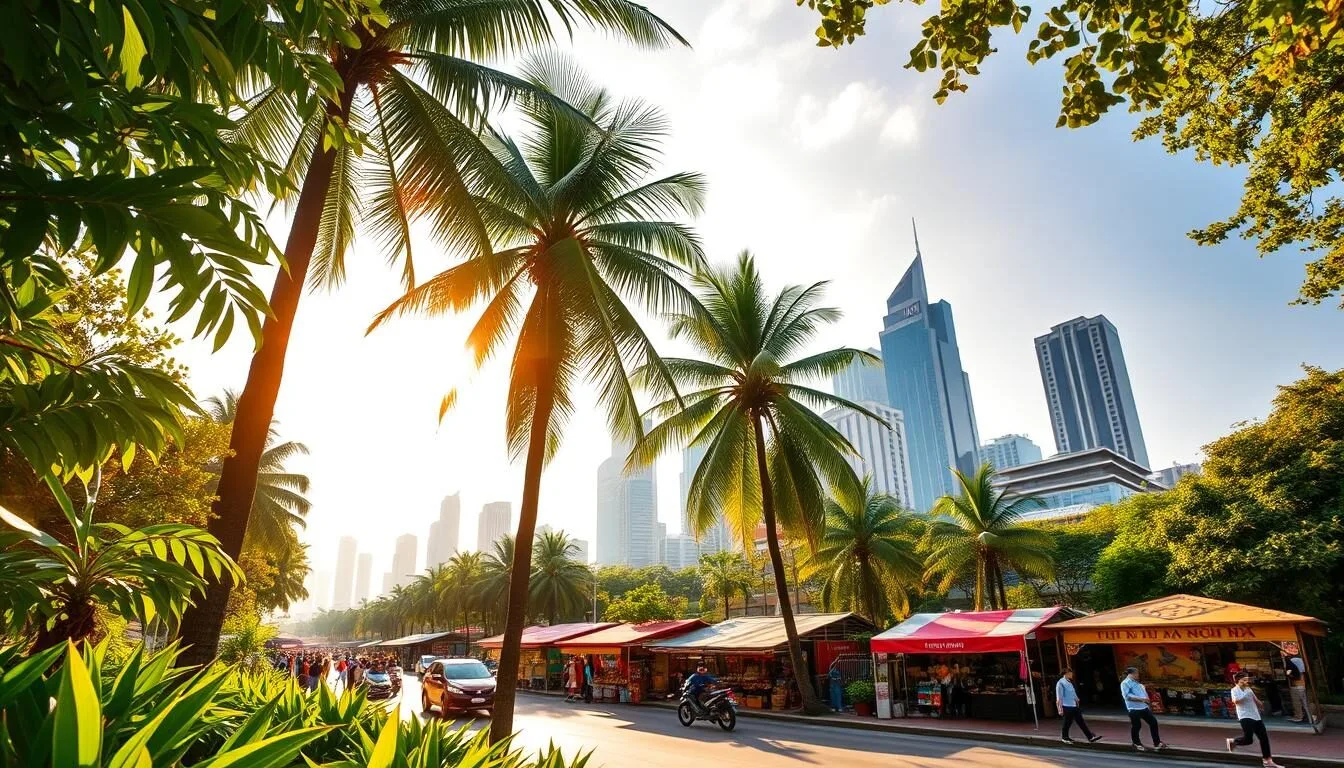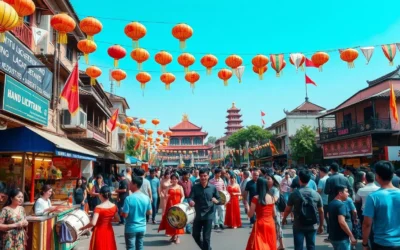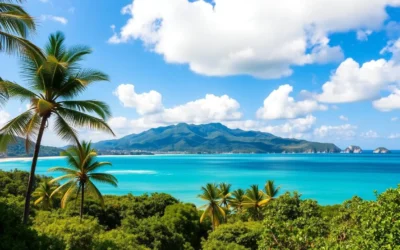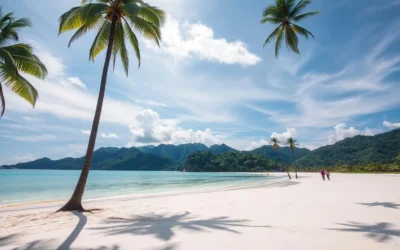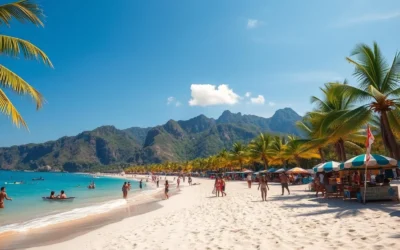✓ Accommodations✓ Flights✓ Rental Cars
Did you know that Southeast Asia’s climate can significantly impact your travel plans? With its rich culture and breathtaking landscapes, a city in this region is a must-visit destination. However, the weather can be quite unpredictable, making it essential to plan your trip during the right months.
When you’re planning to visit this vibrant city, you want to make the most of your weather-savvy trip. The dry season is the perfect time to explore the city’s attractions without the hindrance of rain. You’ll be able to enjoy the local cuisine, visit historical landmarks, and take in the city’s energy.
Let’s dive into the best time to visit and make your trip an unforgettable experience.
Understanding Ho Chi Minh City’s Climate
To make the most of your visit to Ho Chi Minh City, it’s essential to grasp the local climate conditions. Ho Chi Minh City experiences a tropical monsoon climate, characterized by high temperatures and high humidity levels throughout the year.
Tropical Monsoon Climate Overview
The tropical monsoon climate in Ho Chi Minh City is marked by abundant rainfall and distinct seasonal variations. This climate type is typical for regions near the equator and is influenced by the monsoon winds. The city enjoys plenty of sunshine throughout the year, with average temperatures ranging from 26°C to 32°C (79°F to 90°F). The high humidity can make the heat feel more intense, so it’s crucial to stay hydrated and protected from the sun.
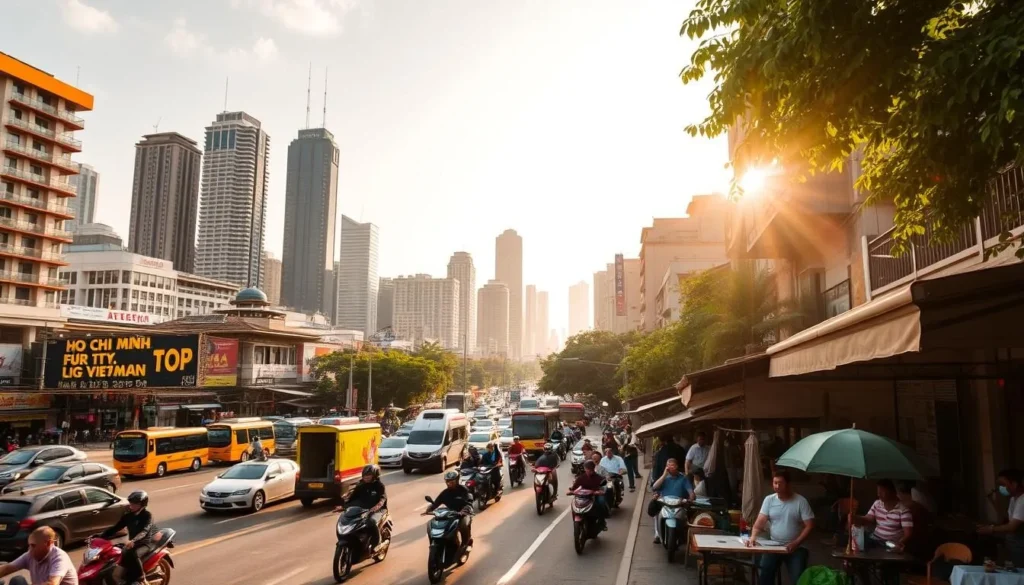
Two Distinct Seasons: Dry and Rainy
Ho Chi Minh City’s climate is divided into two main seasons: the dry season and the rainy season. The dry season typically runs from November to April, characterized by less rainfall and lower humidity. This period is ideal for outdoor activities and sightseeing. In contrast, the rainy season spans from May to October, with frequent rain showers and higher humidity. While the rain can be heavy at times, it usually doesn’t last long, and the city remains vibrant with activities.
By understanding these seasonal variations, you can better plan your trip to Ho Chi Minh City, ensuring a more enjoyable and stress-free experience.
Ho Chi Minh City, Vietnam: Best Months for a Weather-Savvy Trip
To make the most of your trip to Ho Chi Minh City, it’s crucial to know the best months to visit based on weather conditions. The city’s tropical monsoon climate means there are distinct seasons that can significantly impact your travel plans.
December to February: Prime Visiting Time
The months from December to February are considered the prime visiting time for Ho Chi Minh City. The weather is dry and relatively cool, making it ideal for exploring the city’s attractions without the discomfort of excessive heat or rain. You can enjoy outdoor activities like visiting the Cu Chi Tunnels or taking a stroll along the Saigon River without worrying about the weather.
| Month | Average Temperature | Rainfall |
|---|---|---|
| December | 28°C | 60 mm |
| January | 29°C | 20 mm |
| February | 30°C | 10 mm |
March to April: Hot but Manageable
As the dry season progresses, March and April can be quite hot, with temperatures often reaching their peak. However, with proper planning, you can still have a great time. Stay hydrated and plan indoor activities during the hottest part of the day. Visiting museums or shopping centers can be a good way to escape the heat.
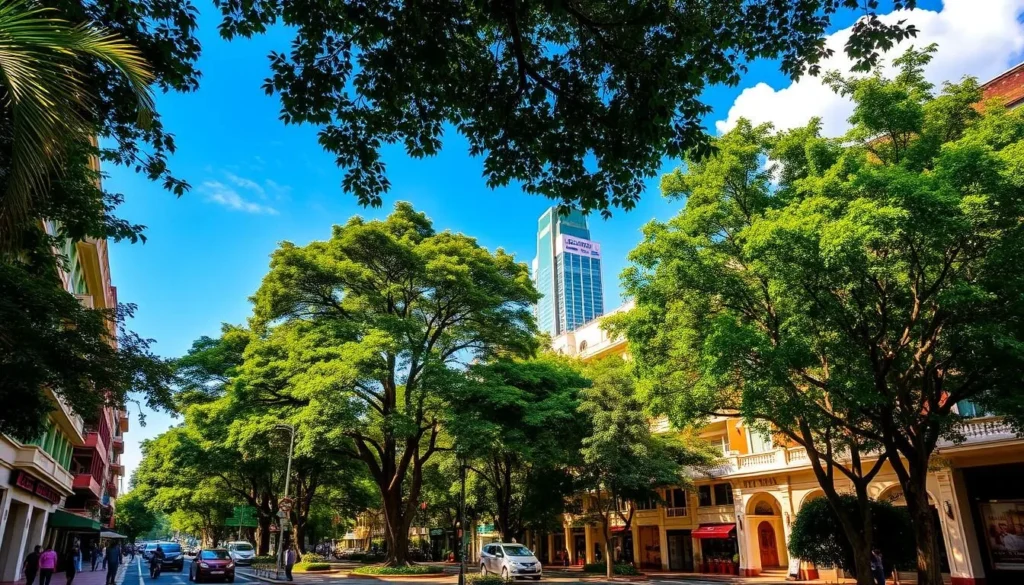
November: The Transition Month
November is a transition month, marking the end of the rainy season. The weather starts to clear up, making it a good time to visit before the peak dry season. Expect fewer tourists than in the peak months, and you might find better deals on accommodations. It’s a great time for outdoor activities as the rain subsides.
By understanding the best months to visit Ho Chi Minh City, you can plan a more enjoyable and stress-free trip. Whether you choose the prime visiting time or the shoulder season, being prepared for the weather will enhance your travel experience.
Month-by-Month Weather Guide
Ho Chi Minh City’s climate varies significantly throughout the year, and knowing what to expect can make or break your trip. Understanding the weather patterns on a month-by-month basis is essential for planning a successful visit.
Dry Season Months (December-April)
The dry season in Ho Chi Minh City is characterized by warm temperatures and low humidity, making it a popular time for tourists to visit.
Temperature and Humidity Patterns
During the dry season, temperatures range from 26°C to 33°C (79°F to 91°F), with an average humidity level of around 60%. The comfortable humidity makes outdoor activities enjoyable.
Rainfall Expectations
Rainfall is scarce during the dry season, with an average of less than 50 mm (2 inches) per month. You can expect plenty of sunshine throughout the day.
| Month | Average Temperature (°C) | Average Rainfall (mm) |
|---|---|---|
| December | 28 | 10 |
| January | 27 | 15 |
| February | 29 | 5 |
| March | 30 | 20 |
| April | 32 | 40 |
Rainy Season Months (May-November)
The rainy season brings a different set of weather conditions, with increased humidity and rainfall. However, the rain showers are often followed by sunshine, and the city’s atmosphere becomes lush and green.
Monsoon Patterns and Intensity
The monsoon season in Ho Chi Minh City is characterized by heavy but short rain showers, usually occurring in the late afternoon or evening. The intensity of the rain can be significant, but it rarely lasts all day.
Humidity and Heat Index
During the rainy season, the humidity levels rise to around 80%, making the temperature feel hotter than it actually is. The heat index can make the perceived temperature feel like it’s over 40°C (104°F) at times.
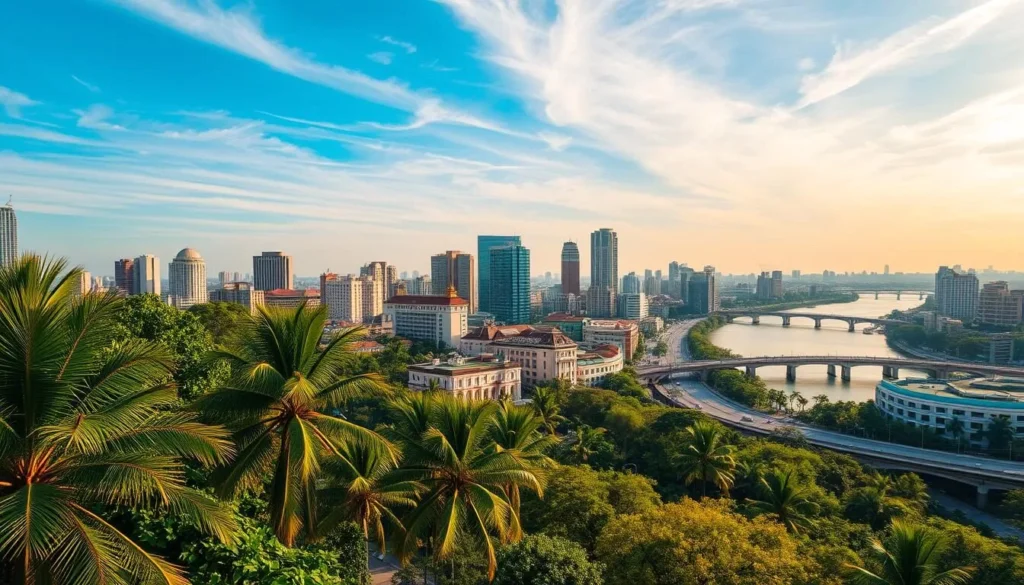
| Month | Average Humidity (%) | Average Rainfall (mm) |
|---|---|---|
| May | 75 | 150 |
| June | 80 | 180 |
| July | 80 | 200 |
| August | 80 | 180 |
| September | 85 | 220 |
By understanding the month-by-month weather patterns in Ho Chi Minh City, you can better plan your trip, making the most of the dry season or being prepared for the rainy season.
Planning Your Visit Around Festivals and Events
To truly immerse yourself in the culture of Ho Chi Minh City, consider visiting during one of its many festivals and events. The city’s vibrant cultural scene is a reflection of its rich history and the blend of traditional and modern influences.
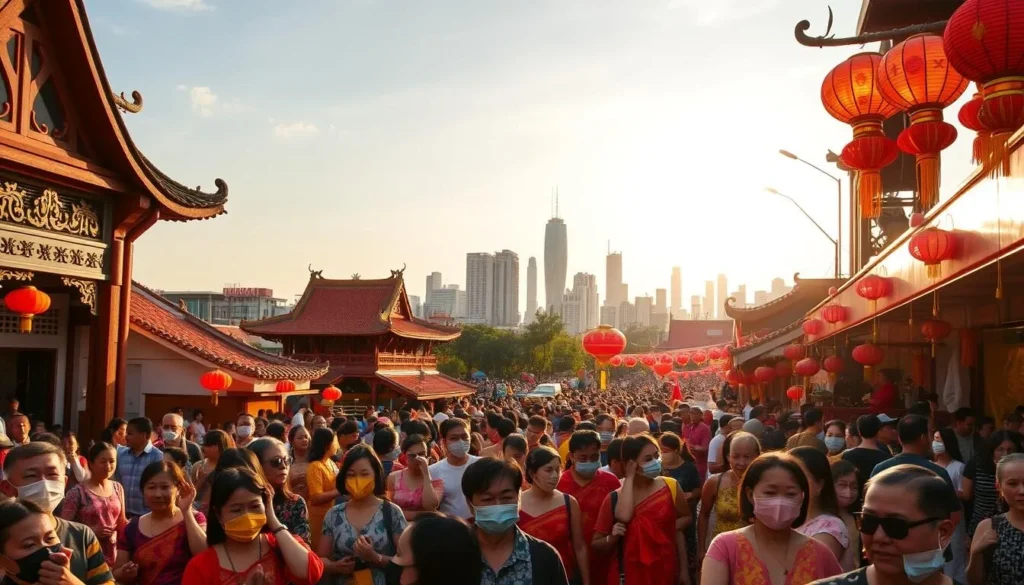
Tet Holiday Experience
The Tet Holiday, or Lunar New Year, is the most significant celebration in Vietnamese culture. It’s a time when locals return to their hometowns, and the city is filled with a festive atmosphere. You can experience the city’s traditional decorations, try local delicacies, and witness the lion dances and fireworks displays.
Mid-Autumn Festival
The Mid-Autumn Festival is another highlight, especially for families. The city comes alive with lantern-making workshops, traditional performances, and the distribution of mooncakes. It’s a magical time, particularly for children, as they carry lanterns through the streets, creating a mesmerizing spectacle.
Other Notable Celebrations
Apart from Tet and the Mid-Autumn Festival, Ho Chi Minh City hosts various other celebrations throughout the year. These include the Vietnamese Women’s Day, full moon parties, and cultural festivals showcasing the city’s diversity. Each event offers a unique insight into the local culture and is worth experiencing.
Budget-Friendly Travel Seasons
If you’re looking to save money on your trip to Ho Chi Minh City, consider visiting during the budget-friendly travel seasons. These periods offer a great balance between affordability and experience.
Low Season Advantages
Visiting Ho Chi Minh City during the low season, from May to August, can be cost-effective. Although it’s within the rainy season, the rain showers are typically short, and you can still enjoy many outdoor activities. Lower accommodation prices and fewer tourists make it an attractive time for budget travelers. You can also enjoy local festivals like the Buddha Day in May, which offers a unique cultural experience.
| Month | Average Accommodation Price | Tourist Season |
|---|---|---|
| May | $30/night | Low |
| June | $28/night | Low |
| July | $29/night | Low |
| August | $30/night | Low |
Shoulder Season Opportunities
The shoulder season, which includes April and November, offers another budget-friendly option. The weather is generally pleasant, and you’re likely to find discounts on tours and accommodations. In April, the dry season is still in full swing, while November marks the beginning of the dry season after the rains. 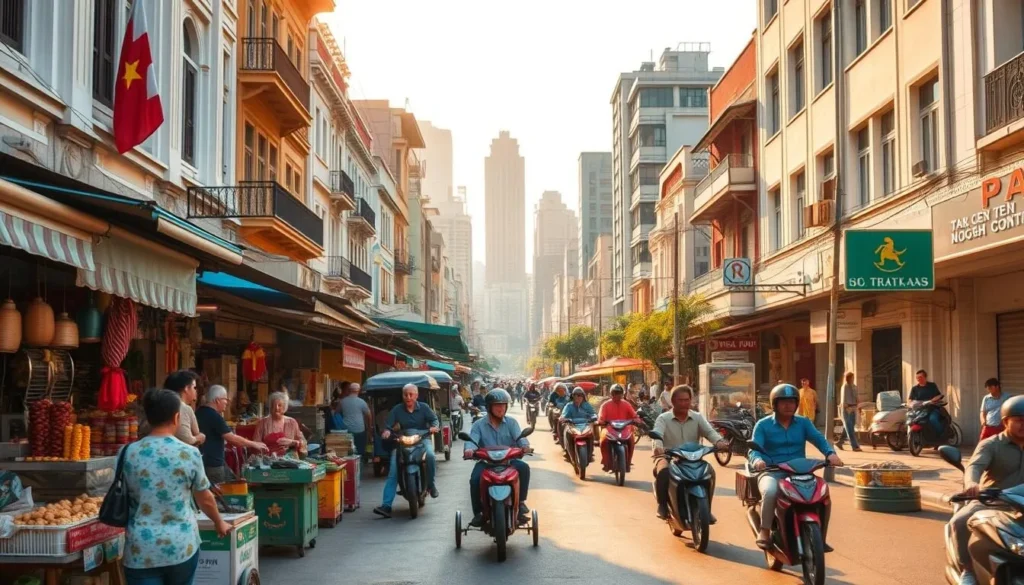 Both periods are ideal for exploring the city’s attractions without the peak season crowds.
Both periods are ideal for exploring the city’s attractions without the peak season crowds.
Packing Essentials for Different Seasons
To ensure a comfortable trip to Ho Chi Minh City, it’s essential to pack according to the season you’re visiting in. The city’s tropical monsoon climate means there are distinct dry and rainy seasons, each requiring different preparations.
Dry Season Packing List
During the dry season, from December to April, Ho Chi Minh City experiences warm and dry weather. You’ll need:
- Lightweight, breathable clothing
- Sun protection (sunscreen, sunglasses, hat)
- Comfortable walking shoes
- A light jacket for cooler mornings and evenings
Tip: Stay hydrated by packing a refillable water bottle.
Rainy Season Packing List
The rainy season, from May to November, brings heavy downpours and high humidity. Your packing list should include:
- Waterproof or rain jacket
- Umbrella or rain poncho
- Quick-drying clothes
- Waterproof bags or covers for electronics
Remember: Even during the rainy season, the rain often comes in short, intense bursts, so be prepared to enjoy sunshine too.
Making the Most of Rainy Season Visits
The rainy season in Ho Chi Minh City presents a unique set of opportunities for travelers. With some planning, you can enjoy the city’s attractions without the crowds and heat. Here’s how to make the most of your visit.
Morning Activity Planning
You can plan your outdoor activities for the morning when the rain is less likely. This way, you can explore the city’s outdoor attractions like the War Remnants Museum and Notre Dame Cathedral without getting caught in the rain. Use the afternoons to relax at your hotel or explore indoor attractions.
Indoor Attractions and Experiences
Ho Chi Minh City has a wealth of indoor attractions that are perfect for rainy days. You can visit the Cu Chi Tunnels, explore the History Museum, or enjoy shopping at the many malls and markets. For a unique experience, consider visiting the city’s many cafes or taking a cooking class to learn about Vietnamese cuisine.

Navigating Potential Flooding
While flooding can be a issue during the rainy season, there are ways to navigate it. Stay informed about weather forecasts and plan your itinerary accordingly. Consider using ride-hailing apps or taxis to get around, and be prepared for occasional waterlogging. Many attractions are designed with flooding in mind, so you can still have a great time.
| Tips for Rainy Season | Benefits |
|---|---|
| Plan morning outdoor activities | Avoid getting caught in the rain |
| Explore indoor attractions | Discover unique experiences |
| Stay informed about weather forecasts | Navigate potential flooding |
Conclusion: Your Perfect Time to Visit Ho Chi Minh City
The best time to visit Ho Chi Minh City depends on your preferences and what you want to do. If you’re looking for dry and comfortable weather, December to February is ideal. For a more budget-friendly trip, consider the low season from May to August. Regardless of when you visit, Ho Chi Minh City’s rich culture, history, and vibrant atmosphere ensure a memorable experience. Plan ahead, pack accordingly, and you’ll be ready for an unforgettable adventure in this dynamic city.
The above is subject to change.
Check back often to TRAVEL.COM for the latest travel tips and deals.
